How to Optimize Your Home for Robot Vacuum Mapping

Robot vacuum cleaners are a revolutionary tool for maintaining a clean home with minimal effort. However, to harness their full potential, it’s essential to optimize your home for accurate and efficient mapping. Proper preparation can enhance the robot vacuum’s navigation capability, ensure thorough cleaning, and reduce potential malfunctions. This guide delves into understanding the technology behind robot vacuum mapping, preparing your home, setting up no-go zones, and maintaining the device for consistent performance. Let’s explore how to create an ideal environment for your robot vacuum with mapping and maximize its cleaning efficiency.
Understanding Robot Vacuum Mapping Technology
How Robot Vacuums Use Mapping Sensors
Robot vacuums rely on various sensors to navigate and clean your home effectively. These sensors help the device detect obstacles, measure distances, and create a map of the area. Commonly used sensors include ultrasonic, infrared, and bump sensors. These tools work together to help the vacuum understand its surroundings and avoid collisions.
The Role of LiDAR and Camera-Based Mapping
Two advanced technologies used in robotic vacuum mapping are LiDAR (Light Detection and Ranging) and camera-based systems. LiDAR uses laser beams to measure the distance to objects and create detailed, accurate maps. This technology allows vacuums to operate effectively in low-light conditions. On the other hand, camera-based systems use visual data to understand the environment, relying heavily on ambient lighting. Both technologies enhance the vacuum’s ability to map rooms, navigate effectively, and perform detailed cleaning tasks.
Benefits of Precise Mapping for Cleaning Efficiency
Accurate mapping significantly boosts a robot vacuum’s cleaning efficiency. With a detailed map, the vacuum can chart an optimized cleaning path, avoid obstacles, and ensure no area is missed. Precise mapping also minimizes redundant cleaning passes, saving battery life and overall time. Additionally, it allows for customized cleaning schedules and targeted cleaning of specific areas, enhancing the device’s functionality and your home’s cleanliness.
See also: Open-Ear Earbuds: A New Era in Audio Technology
Preparing Your Home for Accurate Mapping
Decluttering Floors for Unobstructed Navigation
A clear and clutter-free floor is essential for your robot vacuum to navigate efficiently and create accurate maps. Remove items such as toys, shoes, cables, and other small objects from the floor, as these can obstruct the vacuum’s path and confuse its sensors. Ensuring a clear pathway reduces the chances of the vacuum getting stuck and enhances its overall performance.
Optimizing Lighting for Camera-Based Vacuums
If your robot vacuum uses a camera-based system, proper lighting is crucial. Ensure that rooms have adequate lighting, especially in areas where the robot primarily operates. In darker spaces, consider leaving lights on during cleaning cycles to aid the vacuum’s camera in detecting and mapping its surroundings effectively. Good lighting helps the vacuum capture clear images, ensuring precise navigation and mapping.
Placing the Charging Dock Strategically
The placement of the charging dock is critical for efficient vacuum operation. Position the dock in an open area with a few feet of clearance on all sides. This ensures the vacuum can easily locate and return to the dock to recharge without interruption. Avoid placing the dock in cluttered or tight spaces, as this can hinder the vacuum’s ability to navigate back without difficulty, ensuring seamless operation and consistent cleaning routines.
Utilizing Virtual Boundaries and No-Go Zones
How to Set Up No-Go Zones Effectively
No-go zones are areas where you don’t want the robot vacuum to enter. These zones can be set up using boundary strips or through the vacuum’s mobile app. Identify areas like pet feeding spots, delicate rugs, or cluttered spaces, and mark these as no-go zones. Setting precise boundaries ensures the vacuum avoids sensitive areas, preventing potential damages or disruptions.
Using Apps to Customize Cleaning Areas
Many robot vacuums come with companion apps that allow you to customize and control cleaning zones. Use these apps to divide your home into specific sections, such as rooms or zones requiring focused cleaning. You can schedule cleaning sessions for each area, ensuring a systematic and thorough cleaning process tailored to your home’s unique needs.
When to Use Boundary Strips vs. Digital Barriers
Boundary strips and digital barriers serve as physical and virtual limits for your robot vacuum. Boundary strips are ideal for quick, temporary solutions, such as blocking off holiday decorations or play areas. Digital barriers, set up through apps, provide a more flexible and permanent solution. Choose the method that best suits your needs, considering factors like ease of use, layout changes, and the areas requiring protection.

Regular Maintenance for Consistent Performance
Cleaning Sensors and Brushes Regularly
Regular maintenance ensures your robot vacuum performs efficiently. Clean the sensors, brushes, and wheels frequently to prevent dust and debris buildup. Wipe the sensors with a soft, dry cloth to maintain clear vision for navigation. Remove hair and dirt from the brushes to maintain optimal suction and cleaning ability. Regular upkeep keeps the vacuum operating at its best.
Updating Firmware for Improved Mapping Accuracy
Stay updated with the latest firmware updates for your robot vacuum. Manufacturers provide these updates to enhance performance, fix bugs, and improve mapping and navigation algorithms. Regularly check the vacuum’s app for any available updates and install them promptly. Keeping the firmware updated ensures your vacuum benefits from the latest technology advancements and operates at peak efficiency.
Conclusion
Optimizing your home for robot vacuum mapping involves understanding the technology, preparing your environment, setting boundaries, and maintaining the device regularly. By following these steps, you can enhance your robot vacuum’s efficiency, ensure thorough cleaning, and prolong its lifespan. A clutter-free floor, appropriate lighting, strategic dock placement, and well-defined no-go zones create an ideal environment for your vacuum to navigate and clean seamlessly. Regular maintenance, including cleaning the sensors and updating firmware, ensures consistent performance. Embrace these practices to maximize your robot vacuum’s potential and keep your home spotless with minimal effort.



![FLUX.1 Kontext [dev] Empowered: One Image, N Styles, Unlimited Creativity](https://arcenturfturf.com/wp-content/uploads/2025/07/4-1-390x220.png)



